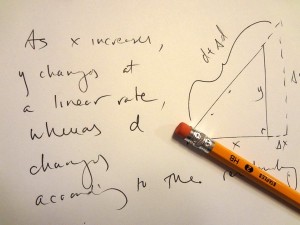 Schoolbook ran a piece on yet another terrible test question, this one appearing on the New York State fifth grade math exam. The most disturbing part of the situation is that no one really seems to understand just how bad this question is.
Schoolbook ran a piece on yet another terrible test question, this one appearing on the New York State fifth grade math exam. The most disturbing part of the situation is that no one really seems to understand just how bad this question is.
The New York Times framed the issue as requiring the student to use a technique outside the normal curriculum; the problem is worse than that. The NYS education commissioner dismissed the error as a “typo”‘; the error can not be considered a typo. The chancellor of the NY Board of Regents decreed that anyone who claims the tests are invalid is just pushing back against teacher evaluations; no one who understands mathematics can claim that this question is valid.
The problem starts with a trapezoid of sides 5, 16, 13, and 28. After asking the student to find the perimeter of the trapezoid, the problem then states
A new trapezoid is formed by doubling the lengths of sides AB and CD. Find the perimeter of the new trapezoid.
 And here’s where the trouble begins.
And here’s where the trouble begins.
1) Is this a right trapezoid?
The Schoolbook piece assumes that the trapezoid is a right trapezoid, i.e., that angle ADC is a right angle. Nowhere in the problem is it stated or indicated that the trapezoid is right. And even if we know that it is right, 5th graders are not expected to know the Pythagorean Theorem.
2) Why does BC change while AD remains constant?
The Schoolbook piece also assumes that as AB and CD are doubled, the length of AD remains constant while the length of BC changes. Thus, in order to find the new perimeter, the student must find the new length of BC (using the Pythagorean Theorem).
This is the critical error in the construction of this problem: the test authors don’t seem to understand the subtleties of scaling figures.
Doubling AB and CD doesn’t specify a unique new trapezoid. BC could change while AD remains constant; AD could change while BC remains constant; AD and BC could both change. (It is interesting to note that it is impossible to double AB and CD while keeping both AD and BC constant).
Was the original intent to tell the students, or have them assume, that the angles stayed the same? If so, the resulting figure could not exist.
Was the original intent to tell the students, or have them assume, that AD was also supposed to be doubled? If so, this still doesn’t specify a unique new trapezoid (unless the angles also remain constant).
The concept of this problem is fundamentally flawed, and it demonstrates a real lack of mathematical understanding on the part of those who created, edited, and screened it.
What’s worse, education officials pretend that this is just a ‘typo’, and that this is no reason to question that validity of these tests.
If the consistent appearance of erroneous math questions on state exams year after year doesn’t constitute legitimate criticism of the validity of these exams, then what possibly could?
Related Posts




